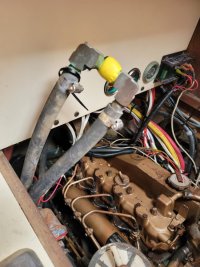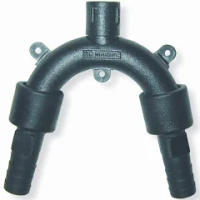You are using an out of date browser. It may not display this or other websites correctly.
You should upgrade or use an alternative browser.
You should upgrade or use an alternative browser.
Anti-siphon valve
- Thread starter Ralph Hewitt
- Start date
Dave G.
1984 E30+ Ludington, MI
Ditto for me.Forespar Marelon vented loop is what I have
Puzzled, I am, as to just where this would be located. None anywhere in our boat. (?)
HerbertFriedman
Member III
I am puzzled as well. When I bought my E34 10 years ago, I had the yard change all the hoses going to the engine. The hose for the sea water intake goes from under the galley sink, under the sole to the engine and I do not see any anti siphon loop.
Alan Gomes
Sustaining Partner
The anti siphon loop is situated in the raw water line before it goes into the exhaust elbow.
So, on a freshwater cooled engine with a heat exchanger (HX), it would be plumbed:
raw water (RW) engine pump out--> RW input side of the HX --> RW out of the HX --> anti siphon loop --> exhaust elbow
So, on a freshwater cooled engine with a heat exchanger (HX), it would be plumbed:
raw water (RW) engine pump out--> RW input side of the HX --> RW out of the HX --> anti siphon loop --> exhaust elbow
Dave G.
1984 E30+ Ludington, MI
The anti-syphon is installed between the heat exchanger outlet and the exhaust mixing elbow. It prevents water backing into the exhaust manifold and engine. Mine is a little different than Christians as it has a hose connected to the vent which runs to the transom and out a 1/2" ish thru-hull.
Alan Gomes
Sustaining Partner
These are OK, but the problem is that the little duckbill valve located inside the cap on top can get crusty with salt and fail to function properly.Forespar Marelon vented loop is what I have, but there are other, cheaper options on line.
Barb size depends on hose size.
View attachment 46437
One solution to this is to remove the duckbill valve altogether and insert an appropriately-sized, small diameter hose (tubing) in the hole in the cap. This hose then needs to be routed somewhere to allow for the water to be discharged, such as a small through hull fitting.
The beauty of that solution is that it will not be prone to clogging and require no maintenance. This is what Ericson did on my boat--though they did not use the Forespar vented loop but cobbled one together from some bronze plumbing bits.
Dave G.
1984 E30+ Ludington, MI
Mine was like that too and was failing so I replaced it.though they did not use the Forespar vented loop but cobbled one together from some bronze plumbing bits.
Alan Gomes
Sustaining Partner
Ditto. Mine fell apart where they had brazed a nipple on the fitting. I put together a replacement with off-the-shelf plumbing parts.Mine was like that too and was failing so I replaced it.
Ah so. My error. My former Universal M25XP did have a "T" fitting in the water line that went to the exhaust elbow, and the top of the T had a 1/4" hose that went aft to a little thru hull on the transom.
When we changed to the Betamarine, they said we could keep it or dispense with it. So I did not continue to use one. Note that the EY installation was not a "vented loop" but rather a connection to a piece of tuning that would allow air to enter the tubing after the engine was shut down. While running the little thru hull on the transom would emit a small stream of water.
When we changed to the Betamarine, they said we could keep it or dispense with it. So I did not continue to use one. Note that the EY installation was not a "vented loop" but rather a connection to a piece of tuning that would allow air to enter the tubing after the engine was shut down. While running the little thru hull on the transom would emit a small stream of water.
Alan Gomes
Sustaining Partner
That's the one!Ah so. My error. My former Universal M25XP did have a "T" fitting in the water line that went to the exhaust elbow, and the top of the T had a 1/4" hose that went aft to a little thru hull on the transom.
When we changed to the Betamarine, they said we could keep it or dispense with it. So I did not continue to use one. Note that the EY installation was not a "vented loop" but rather a connection to a piece of tuning that would allow air to enter the tubing after the engine was shut down. While running the little thru hull on the transom would emit a small stream of water.
What was there about your installation that made them say they didn't think you needed one?
Dave G.
1984 E30+ Ludington, MI
Yes as that is a better way to do it. A vented loop would accomplish the same function but maintenance and failure complications are eliminated with the "drain" hose plumbing. Yes I also would like o know how the Beta repels the backwash issues.Note that the EY installation was not a "vented loop" but rather a connection to a piece of tuning that would allow air to enter the tubing after the engine was shut down
On Ralph's boat and mine, the vented loop installed between HX and exhaust is located very high. It's hidden by a panel and accessed through the lazarette. The Marelon product can be located at bridge deck height because there is space between the cabin bulkhead (brown plywood) and the molded cockpit.
Not all boats allow such height above waterline, and a vent hose, to be led higher, can replace the vent cap and its built-in rubber duckbill. Forespar says to lubricate the duckbill occasionally with grease, or at least manipulate it. But nobody bothers when the installation is hidden. When the rubber fails after 30 years, evidence is water spray and replacement of the duckbill is easy.

Not all boats allow such height above waterline, and a vent hose, to be led higher, can replace the vent cap and its built-in rubber duckbill. Forespar says to lubricate the duckbill occasionally with grease, or at least manipulate it. But nobody bothers when the installation is hidden. When the rubber fails after 30 years, evidence is water spray and replacement of the duckbill is easy.

I do not know for sure but suspect that the height of the engine exhaust above the waterline is the important factor. My SWAG is that EY did this routinely on all of the King designs because the hull was deep enough that the engine was mounted just low enough to have some little potential for back flooding, sometimes. The Olson has a more shallow hull form aft, so the engine (and top of exhaust) is a bit higher.What was there about your installation that made them say they didn't think you needed one?
Only my guess, tho. Before my am coffee, that's the best I got....
Dave G.
1984 E30+ Ludington, MI
I was curious and looked on the Beta sight & they do sell them for their engines. I guess engine and or HX height may have something to do with it ? I had always thought it was more to do with the seawater pump and where the water pressure is in the line particularly when the engine is shut down.


Ralph Hewitt
Member III
Hose comes off sea water pump and up to loop as shown to cool exhaust system.Puzzled, I am, as to just where this would be located. None anywhere in our boat. (?)
Ralph Hewitt
Member III
For me, I feel more comfortable with a High vented loop...Yes as that is a better way to do it. A vented loop would accomplish the same function but maintenance and failure complications are eliminated with the "drain" hose plumbing. Yes I also would like o know how the Beta repels the backwash issues.
Our sailing in done in open Ocean many times loaded with following deep Seas.


